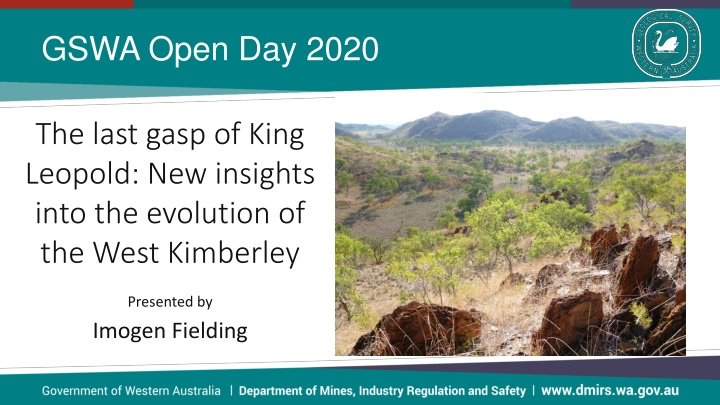
Insights into the Evolution of the West Kimberley: Metamorphic Mapping and Geochronological Studies
Explore the tectonic evolution of the State with studies on the King Leopold Orogen, in situ monazite geochronology, and pressure-temperature estimates. Gain valuable insights into the geological history and metamorphism of the region.
Download Presentation

Please find below an Image/Link to download the presentation.
The content on the website is provided AS IS for your information and personal use only. It may not be sold, licensed, or shared on other websites without obtaining consent from the author. If you encounter any issues during the download, it is possible that the publisher has removed the file from their server.
You are allowed to download the files provided on this website for personal or commercial use, subject to the condition that they are used lawfully. All files are the property of their respective owners.
The content on the website is provided AS IS for your information and personal use only. It may not be sold, licensed, or shared on other websites without obtaining consent from the author.
E N D
Presentation Transcript
GSWA Open Day 2020 The last gasp of King Leopold: New insights into the evolution of the West Kimberley Presented by Imogen Fielding
State metamorphic mapping project External studies (not exhaustive) Recent (post-2010) Older (pre-2010) or less robust Pressure (P) Temperature (T) time (t) data Defining the tectonic evolution of the State GSWA studies Completed In progress Planned Methods P T estimates phase equilibria modelling thermobarometry, mineral chemistry (t) in situ monazite geochronology dating metamorphism and fabric development
In situ monazite geochronology In situ analyses textural setting preserved metamorphism mineral assemblages monazite aligned in fabrics small grains analysed Garnet with monazite inclusion Why monazite? REE-rich phosphate mineral grows during metamorphism and hydrothermal activity dissolution reprecipitation reactions can mean multiple ages preserved low common Pb
King Leopold Orogen King Leopold Orogen Lamboo Province Western Zone Paleoproterozoic metasedimentary and igneous rock 4 orogenic events 1870 1850 Ma Hooper Orogeny 1835 1805 Ma Halls Creek Orogeny 1400 1000 Ma Yampi Orogeny 670 510 Ma King Leopold Orogeny
Project aims P T t data for the King Leopold Orogen Faults thought to have formed during the 1400 1000 Ma Yampi Orogeny
Linking metamorphism and deformation Garnet staurolite schist Foliation defined by muscovite + biotite + quartz Garnet has helical inclusion trails Inclusion trails in garnet and staurolite aligned in fabric biotite/muscovite 210674 garnet Granite 210673 210664 staurolite 210670 210671 95536 Marboo Formation biotite/muscovite quartz 1 km garnet
Pressure (P) temperature (T) estimates Garnet + staurolite + biotite + muscovite Peak conditions 580 630 C and 5 6 kbar Crustal thickening 15 13 Depth (km) 10 T ( C)
Proximal to Billyarra Shear Zone Monazite aligned in fabric 502 3 Ma (n = 50; MSWD = 0.94) 502 3 Ma
Distal to Billyarra Shear Zone Preservation of Paleoproterozoic metamorphism 210673 c. 500 and 1730 Ma (preliminary results) 210674 EPMA maps show c. 1850 Ma core and narrow c. 500 Ma rim 210674 Granite 210673 Marboo Formation 505 5 Ma 502 3 Ma 501 3 Ma c. 500 Ma 1 km
Conclusions Fault movement previously linked to the 1400 1000 Ma Yampi Orogeny However: geochronology indicates deformation occurred at c. 500 Ma accompanied by a significant metamorphic event Barrovian-style (regional) metamorphism to a minimum depth of ~13 km hydration along active shear zones promotes equilibration during this event No evidence of the Yampi Orogeny Extension of the 670 510 Ma King Leopold Orogeny
